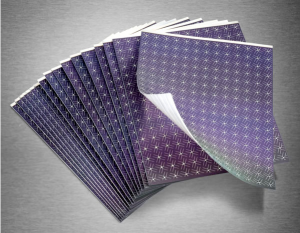“Imagine a solar panel without the panel. Just a coating, thin as a layer of paint, that takes light and converts it to electricity… Consider solar-powered buildings stretching not just across sunny Southern California, but through China and India and Kenya as well, because even in those countries, going solar will be cheaper than burning coal.” –MICHAEL MOYER
This snippet from Michael Moyer’s article “The New Dawn of Solar,” featured in Popular Science, shines light on some of the most innovative solar technology on the market. This is not speculation or a cooked up fantasy from an alternative power engineer in a lab, but an actual product produced by the company Nanosolar that is backed by prominent leaders such as Google’s founders and the U.S. Department of Energy for $20 million. Check out how it works.
Nanosolar Technology Overview from Nanosolar Communications on Vimeo.
Wait, what is so amazing about this product? Hasn’t the basic technology been around for decades?
For one thing, PowerSheet solar cells are made in a printing-press fashion. So similar to how paper is printed out, the printing machines will set down a layer of solar-absorbing nano-ink onto metal sheets. No more glass, no more heavy, dangerous materials, no more expensive and strained resources like silicon; just aluminum foil thin sheets that can be produced at a rate of several hundred feet per minute! On top of that, the cells are more flexible. Panels are no longer limited to roof tops but can be incorporated into roof shingles, window coatings, doors, and so on. The possibilities are really endless with this technology!
“It really is quite a big deal in terms of altering the way we think about solar and in inherently altering the economics of solar”– Dan Kammen, Founding Director of the Renewable and Appropriate Energy Laboratory at the University of California at Berkeley.
Yet the real reason PowerSheet has been given so much support is because it’s cheap. Cost effectiveness of solar has always been one of its biggest problems and with fewer materials used in the PowerSheet, particularly silicon, the expense to produce, ship, and install this technology has decreased drastically. How drastically? Nanosolar is going full steam ahead with its most efficient production methods turning out commercial cells for as little as 30 cents a watt. That is a huge gain in comparison to the older method where even the cheapest solar panels cost about $3 per watt of energy.
With such advancements the future is looking bright for solar. Look out coal!
Sources: 1′ Moyer, Michael. “The New Dawn of Solar.” Popular Science. Popular Science, Dec. 2007. Web. Jan. 2012. <http://www.stumbleupon.com/su/2nDB3q/www.popsci.com/popsci/flat/bown/2007/green/item_59.html/>.
2′ www.nanosolar.com







